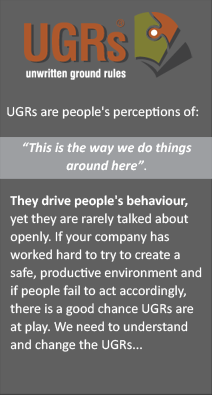





|
What's the process
UGRs are best defined as people’s perceptions of “this is the way we do things around here”. They drive people’s behaviour, yet they are seldom talked about openly. Examples of UGRs in mining include:
UGRs such as these work against safety and bottom-line performance of a company. The best of vision and mission statements, strategic plans, safety training and business plans – even when backed up by policies and procedure documents – count for nothing if the UGRs are not aligned. Research into UGRs has revealed that a remarkable 70% of non-managers believe company productivity could be improved by 50% or more if the negative UGRs in their company were addressed.
We need to start by creating an understanding of corporate culture. We introduce leaders to the UGRs concept. Employees at all levels need to realize that organizational culture is the single most critical factor impacting on results and safety. By helping them to understand how their individual behaviour impacts on the culture within the organization, they become aware of the fact that they are individually responsible for overall results.
The UGRs Stock Take is analysed to identify areas of concern that are impacting on safety and productivity, and to generate strategies to address those areas or aspects of the culture. Then we help you to define what the culture should ideally be like, as a prerequisite to achieving your stated strategic objectives... and we “translate” this ideal culture into required behaviours. Our recommendation is that companies maximise the number of employees who are introduced to the UGRs concept – as it’s a powerful tool that makes sense to everyone. We first work with the senior leadership team to confirm their commitment to tackling the culture of the company and to confirm the process and roles and responsibilities. Once we've got agreement to proceed, we normally embark on a five-step process. Each of these is decribed briefly below.
Envision – Here is where we work with the leadership team to clarify the Key Cultural Attributes (KCAs) necessary to ensure a safe, productive and successful company. This step is vital and beneficial for the leaders, and clarity is gained about the kind of culture that is required to be both safe and productive. Assess – This is where we gain insights into the current culture in terms of the KCAs, and implement improvements based on that evaluation. We conduct a UGRs Stock Take to identify what the current culture is like with regard to each of the KCAs. This also involves determination of strategies to address areas of concern from the Stock Take. Teach – Here is where we familiarise as many people as possible, and especially leaders, with the UGRs concept. This is particularly beneficial as we have discovered over the years that many people subscribe to less-than-positive UGRs but do so unconsciously. After learning about UGRs, many negative, cynical people choose to change their attitude and their behaviours. We have seen the most negative people turn 180 degrees on many occasions! Involve – This stage involves people in creating and prioritising aspirational positive UGRs – linked to the KCAs - by which they would like to characterise the organisation into the future. Again this is a powerful stage as it gets people to change their mindsets from being victims of their present culture to being 'shapers' of it. Embed – this stage involves Identifying and implement strategies to embed the aspirational positive UGRs that were generated in the previous step.
|

 Next, we determine the current prevailing culture within your organization – which is really only the sum total of the individual behaviour of all employees. We identify the existing UGRs in the company via what we call a ‘UGRs Stock Take’. This is a powerful yet simple tool that shows the real UGRs that drive people’s performance.
Next, we determine the current prevailing culture within your organization – which is really only the sum total of the individual behaviour of all employees. We identify the existing UGRs in the company via what we call a ‘UGRs Stock Take’. This is a powerful yet simple tool that shows the real UGRs that drive people’s performance.





